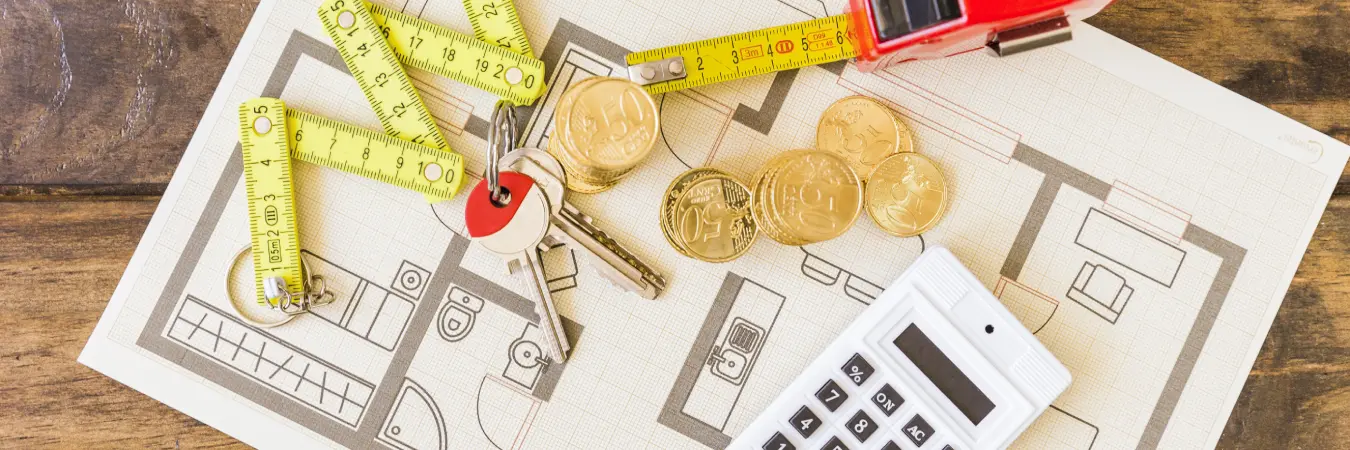Understanding What Carpet Area Means and Its Importance in Real Estate
Table Of Contents
- What is Carpet Area?
- How Does RERA Define Carpet Area?
- How is Carpet Area Calculated?
- What Are the Components Included in the Carpet Area?
- What Components Are NOT Included in the Carpet Area?
- What’s the Difference?: Carpet Area and Built-Up Area
- How to Calculate Carpet Area from Built Up Area
- Difference Between Built up Area and Super Built Up Area
- The Importance of Understanding Carpet Area For Property Deals
What is Carpet Area?
Carpet area is defined as the actual space that can be used inside a residential unit’s confines, essentially eliminating features like decks, walls, as well as common areas. The word refers to the entire floor space that can be covered by a carpet. This is a measurement that is very useful in giving a precise picture of the usable living area of a house by taking into account spaces such as kitchens, living rooms, as well as bedrooms. In the blog below, we at L&T Realty help you get an understanding of what carpet area means and explore its importance in real estate.
When the non-useful areas are removed, the carpet area provides a relatively more accurate estimate of the amount of space that is accessible for individual usage, enabling prospective occupants and renters to evaluate how suitable the layout is for them.
How Does RERA Define Carpet Area?
The net usable floor area inside a residential unit’s walls, excluding the area set aside for balconies, but including the area of the internal walls, is referred to as the carpet area according to RERA guidelines. The goal of RERA’s emphasis on carpet area is to give buyers of properties a clear, uniform measure of evaluating a property’s true living space. By guaranteeing uniformity in real estate dealings, this definition enables purchasers to make well-informed choices based on the functional, usable area they will be able to occupy. RERA’s definition of what is carpet area helps in promoting transparency and accuracy by external walls and shared areas out of the calculations, which strengthens accountability and trust in the real estate market.
How is Carpet Area Calculated?
As mentioned earlier, the standard definition of real estate carpet area and the definition of carpet area set by RERA hold notable differences, and their respective calculations also differ substantially.
Standard Carpet Area
The standard calculation of carpet area sums up the areas of the bedroom, living room, kitchen, balconies and the toilets, while eliminating the area of the thickness of the apartment’s inner walls.
The formula goes as follows:
Carpet area = (bedroom area + living room area + kitchen area + toilets area + balcony area) – thickness of inner walls
RERA Carpet Area
RERA’s calculation of the carpet area of an apartment is the total net usable area of the apartment – which excludes external walls, terrace area, balconies, as well as any verandahs – while also adding the total area of the internal parting walls.
The formula goes as follows:
RERA Carpet Area = Net Usable Area (excluding External walls, verandah, balcony, terrace) + Area of Internal Partition Walls
What Are the Components Included in the Carpet Area?
Bedroom and Living Room
The carpet area includes the main living areas, which are the bedrooms and living rooms. By using these in the calculations, the usable space is evaluated with accuracy, as it takes into account the main places where residents would be spending most of their time.
Kitchen
Another area included in the carpet area is the kitchen’s allocated space. This includes the actual floor area where homeowners can arrange, counters, appliances, as well as fixtures to enhance the overall use of the kitchen.
Bathroom and Toilet
The floor area of restrooms and bathrooms is included in the carpet area as these spaces are vital for day-to-day life, and their inclusion in the carpet area calculation also acts as an indicator of how practical the apartment is.
Storage Units
The carpet area also typically includes wardrobes, cabinets, and other storage spaces in the unit. These areas improve the living space’s general organization and add to its practicality.
Inner Stairs
The floor surface covered by internal staircases may be included in the carpet area of duplex and multi story apartments. This guarantees that when calculating the carpet area, the total usable area across various levels is taken into account.
Internal Partitioning Walls
It’s important to note that while carpet area does not include the thickness of the apartment’s exterior and interior walls, it does count the actual floor area that is taken by the internal partition walls. This measurement takes into account the room’s arrangement and guarantees that a potential resident would be aware of the amount of available space.
What Components Are NOT Included in the Carpet Area?
External Walls
As mentioned earlier, the thickness of the outside walls is not included in the carpet area. To ensure that the calculation represents the actual living space as opposed to the total built area, only the usable spaces within the confines of the walls is taken into account.
Internal Walls
Just like the external walls, the carpet area also does not account for the thickness of the internal walls. This omission makes it so that the calculation takes into consideration only the space needed for fixtures, furniture, and daily operations.
Common Areas and Corridors
The carpet area does not include common areas such as lounges and corridors inside the building. This division aids in preserving a certain uniformity while calculating each unit’s real usable living space.
Utility and Service Areas
Generally speaking, spaces used as laundry areas or service balconies are not included in the carpet area. They offer a number of practical uses but are not included with the primary living space.
What’s the Difference?: Carpet Area and Built-Up Area
Carpet Area
- Refers to the primary usable space within the walls of your apartment.
- The carpet area includes the area where you can lay a carpet, which means excluding walls and common areas.
- The main idea of this concept is to only keep focus on the living area that is practical and is used daily.
- This is certainly a more precise and clear-cut representation of the real available living space.
Built Up Area Calculation
There are many differences between carpet area and built-up area, as reflected in the formula for built-up area calculation :
Built-Up Area = carpet area + wall areas + terrace and balcony
- This area refers to everything that is situated within the unit’s walls
- Built-up area includes the carpet area of the apartment, as well as the thickness of the walls.
- This means that this concept focuses on the whole constructed area of the residential unit.
- Built-up area offers a more holistic representation of the unit by counting aspects such as wall thickness.
How to Calculate Carpet Area from Built Up Area
Its might be worth remembering that if you only know the property’s built-up area and do not know how to calculate carpet area from built-up area, then the same formula can be simply reworked: Carpet Area = Built-up area – (thickness of walls + balcony + other exclusions)
Super Built-Up Area Calculation
The main difference between built-up area and super built-up area is simply the inclusion of common spaces:
Super Built-Up Area = Built-up area + Common area components
Difference Between Built up Area and Super Built Up Area
- Super built-up area goes beyond just your own apartment and also takes into account the common areas.
- This area includes the total built-up area as well as common areas such as corridors and lobbies.
- This focuses on the total built area that is part of the building as a whole.
- Super built-up area seems to be more of a consideration of the project as a whole by including common spaces.
The Importance of Understanding Carpet Area For Property Deals
When it comes to real estate negotiations, it is critical to comprehend the idea of carpet area because it has a direct impact on a property’s worth, use, and general satisfaction. This metric is essential in helping prospective renters as well as homebuyers assess the genuine value of a property since it gives an accurate calculation of the habitable space in a home, omitting unusable portions.
To begin with, understanding carpet area is essential to make wise financial judgments. The quantity of usable area a property offers is frequently the primary factor used by one examining the property, whether it be a homebuyer or prospective renter, to determine its worth. People may compute the value per square foot of the actual living space by knowing what the carpet area is, which makes it possible to compare properties more precisely.
An Example of the Importance of Carpet Area Calculations
Apartment A vs. Apartment B:
Apartment A is advertised as 1,000 square feet, while Apartment B is 900 square feet. Upon inspection, it’s revealed that Apartment A has a super built-up area of 1,200 sq. ft. with a carpet area of 800 sq. ft., while Apartment B has a super built-up area of 1,000 sq. ft. with a carpet area of 900 sq. ft. Apartment B offers more usable space despite having a smaller super built-up area.
FAQ’s About Carpet Area
Why should carpet areas be important to a homebuyer?
For a homebuyer, the carpet area is actually very important since it provides an accurate representation of the usable living space. It assists in determining how functional the apartment is for day-to-day tasks, where to put your furniture, and how comfortable it is in general.
Does carpet area affect the cost of a property?
Indeed, a major factor in deciding the price of a home is its carpet area. Given that the carpet area indicates the actual living space, builders frequently base flat prices on it. You can evaluate the worth of the usable space you are buying by taking into account the carpet area.
Can two apartments have the same built-up area but different carpet areas?
Two apartments with the same built-up area can have different carpet areas. The arrangement of the various rooms, the internal wall layout, and the inclusion or omission of specific spaces are typically the cause of difference. Examining individual floor plans is necessary in order to determine the precise carpet of either apartment.
Expert Insights
- “The carpet area is the true measure of usable space in a property, so it’s crucial for buyers to focus on this when evaluating real estate options.”
– Anuj Puri, Chairman of Anarock Property Consultants - “Buyers should be aware of the carpet area while negotiating prices in the real estate market, as it directly affects the value of the property.”
– Ramesh Nair, CEO & Country Head of JLL India.
Conclusion
The carpet area in real estate clearly holds immense utility, bypassing any unnecessary promotional devices and giving homebuyers a true sense of what they are buying by representing the actual living area within a property. It is a vital tool for purchasers to make well-informed decisions, and for developers it’s a chance to put quality over quantity. Ultimately, this measurement is a key indicator that guides the way towards finding a place that really satisfies the objectives of people looking for a place to call home.
On the lookout for more engaging real estate content? Check out our blog: https://www.lntrealty.com/news-blogs/#blogs
If you are an aspiring home buyer looking to make a dream purchase, be sure to explore the myriad of world-class projects by L&T Realty – offering unrivaled amenities and immense comforts.


